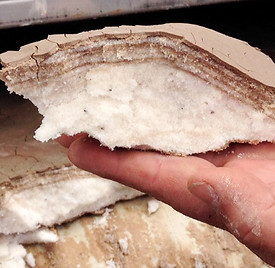

Clean Water and Dry Solids
1 Micron Filtration for liquid solid separations
The Oberlin Filter removes 99.99% of total suspended solids and leaves them in a dry cake.
-
Wastewater Filtration
-
Sludge De-watering and Heavy Metal Removal
-
Primary Filter Backwash, Clarifier Overflows and Underflows
-
Provides a Solids Free Feed for Carbon Bed and Membrane Filters
Water Technology
Dry cake of filtered salt and magnesium from a crystalizer in a Zero Liquid Discharge program at a power plant in Turlock, CA.

The Oberlin Filter solves a large variety of Water-Solid separation problems so our customers can reach the strict requirements of SEWAGE DISCHARGE LIMITS. Its fully automatic features and simple design deliver both dry solids and clean water without operator contact minimizing exposure to hazardous materials.
The Oberlin Filter can filter solids down to 1 micron and has the capability to treat a wide range of wastewater applications ranging from removing heavy metals to sludge dewatering. We treat extreme wastewater such as chemical destruction programs and low-level radiation removal. The processed water is clean enough for reuse or discharge. We operate in challenging applications with high solids, high corrosion and high temperatures.
Oberlin Filter supplies complete system packages and we offer continuing technical support to ensure that you are getting optimal results for your water filtration. Our completely integrated operation includes lab, design and engineering, prototyping, manufacturing with total quality control, startup and testing.
Clean Water
Below are two charts showing how effectively we removed heavy metals from wastewater. The first chart is low level radioactive wastewater from the Savannah River Plant which produced nuclear materials for the U.S. Department of Energy. The second example is a battery manufacturer that had wastewater contaminated with lead, zinc and copper. In both examples the Oberlin Filter cleaned the water to well below the discharge limits.
Low Level Radioactive Water
Property Feed Waste Oberlin Filter NPDES Limits
Turbidity (NTU)
TSS (ppm)
Aluminum (ppm)
Lead (ppm)
Zinc (ppm)
Copper (ppm)
Uranium (ppm)
110
687
127
1.6
0.5
2.0
2.3
.32
1.4
0.95
0.2
<0.1
<0.1
0.01
NR
31
302
0.43
0.32
.21
0.05
Battery Manufacturer
Property Feed Waste Oberlin Filter Discharge Limits*
Turbidity (NTU)
TSS (ppm)
Lead (ppm)
Zinc (ppm)
Copper (ppm)
*NR=Not Regulated
NR
20.0
5.0
5.0
5.0
1.0
2.5
<0.01
0.2
1.2
>1,0000
17,000
40
410
1050
Dry Solids
The Oberlin Filter provides extremely dry solids that automatically discharge from the filter. No further dewatering is necessary. The solids are dry and ready for landfill disposal. The Oberlin is often used as the last step in water treatment systems when total reclamation has become a necessity.
Below is an example of the types of results the Oberlin Filter produces for different substances.
Percent Dryness Solids Type
-
75%-95% Crystalline and Rigid Shaped Particles
-
45%-65% Diatomaceous Earth/Filter Aid Backwashes
-
30%-40% Metal Hydroxides
Dry cake discharging from the Oberlin Filter at a power plant in Turlock, CA. This is an example of the filter's ability to remove a complex variety of substances. The brown substance is magnesium the white is salt. The filter is working with a crystalizer and is the final process step in their Zero Liquid Discharge program.
"The Oberlin Automatic Pressure Filter(APF) is unique in the industry since it's simple, automatic, and can use disposable filter media for the same capacity cycle after cycle. It can be manufactured from many materials of construction to meet the most corrosive environments. It can also handle almost any solids loading and can accommodate in-line filter aid or polymer flocculant addition for enhanced separation efficiency. These are some of the reasons that more than 60 units have been installed in DuPont on a variety of applications including wastewater, recycle water clarification. nuclear waste treatment, and metals recovery."
Dr. Ernest Mayer
Dr. Mayer is a Senior Level Consultant specializing in Solid/Liquid Separation (SLS) technology since 1980. His work with the DuPont Company of Wilmington, Delaware has spanned 40 years. Holding two patents and having published more than two hundred papers, Dr. Mayer is listed in Who’s Who in Science and Environmental Technology and Co-chaired the World Filtration Congress in 2004.
Before and After Wastewater Filtration
The sequence of the video is:
-
Before and after samples with TSS and dry solids
-
A tank of wastewater
-
Clean water coming out of the filter
-
Dry cake of solids coming out of the filter

Large Volumes Compact Size
What sets the filter apart, is it’s ability to process an enormous volume of water through it’s very compact size. With a footprint of only 14.5ft long by 10.33ft wide by 9ft high, a single OPF 50 can process up to 2.8 million gallons of water in a day(application dependent). The Oberlin Filter comes in a variety of sizes to suit a projects needs. Our engineers can design a system to suit the capacity of your flow requiremtns whether it be large or small.
The OPF 50 Filter
14.5ft long x 10.33ft wide x 9ft high
2.8 million gallons a day
Two Oberlin OPF 50 Filters





